-
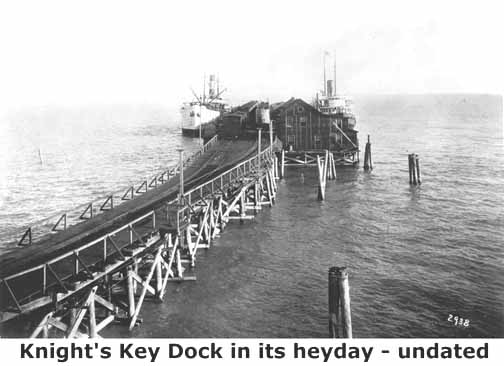 History
of Knight's Key Dock History
of Knight's Key Dock
-
By Jerry Wilkinson
-
-
-
(click to enlarge photos)
-
Without doubt the construction of the
Key West Extension ranks as one of the largest projects in the early 1900s.
It is still conjecture whether it was fostered by a still larger project
such as the Panama Canal etc. However, the Panama Canal was built by a
country where the Key West Extension was built by an individual, Henry
M. Flagler.
-
Regardless, the author wishes to submit
that the construction of Knight's Key Dock was one of the largest supplementary
parts of a larger project (to facilitate but be destroyed after the original
is completed) ever. From 1906 it served as a transfer facility for material
from deep draught ocean transports to shallow draught lighters (barges)
for delivery to various construction sites. From 1908 to 1912 it served
to transfer people and material to and from ocean liners and the Florida
East Coast Railway (FEC) System. It was the southern terminus for the FEC
railroad. After February 22, 1912 it could not be reached by trains and
later was burned to the waterline.
-
Page one will cover the 1906 to
1908 period and page two from 1908 to its end.
-
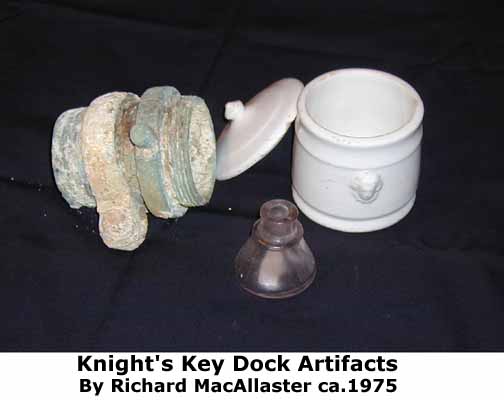 The
details of how it originated are not clear. Other than photos, there is
only underwater evidence in murky waters and swift currents that it existed
and its purpose is difficult to perceive. To the right are artifacts retrieved
by the late Richard MacAllaster. The
details of how it originated are not clear. Other than photos, there is
only underwater evidence in murky waters and swift currents that it existed
and its purpose is difficult to perceive. To the right are artifacts retrieved
by the late Richard MacAllaster.
-
In fact the entire Key West Extension
defies some logic. We assume that Mr. Flagler wished to connect the mainland
with Cuba from statements made in the Flagler System board minutes. It
can be concluded that the fact that Flagler did not have deep water access
during the Spanish American War (1898) and his competitor, Henry Plant,
at Tampa, Florida, did was some concern if no more than to emphasize that
one was needed.
-
From William J. Krome's diary we
know that after the survey route across the Everglades to Cape Sable was
tabled in 1903, he was sent to survey a route to the Turtle Harbor area
off of North Key Largo. Exactly where this deep water access was proposed
in not known, but a three mile pier would reach a 34 foot deep channel
and two miles a 25 foot deep channel to Hawk Channel.
-
Krome was busy surveying Homestead
to Turtle Harbor when in late March 1904 he was called to St. Augustine
to meet Henry Flagler personally for the first time. He submitted the 19
mile route at an estimated cost of about $480,000. Krome was sent to do
other work and on April 25, 1904 he was told the objective would be Key
West, not Turtle Harbor, and on April 30 he was preparing to survey across
the Everglades to Cross Key.
-
 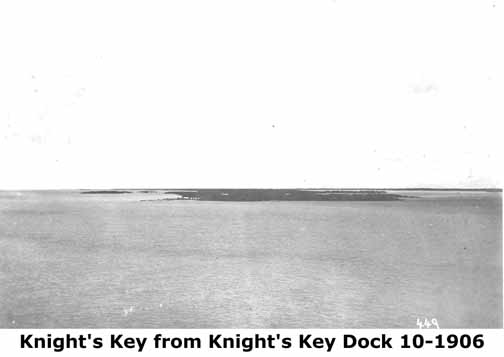
-
How and when Knight's Key Dock
was inserted in the overall project is not known by the author. Work did
not begin just at Homestead and Key West, it began throughout the Keys
in 1905. Some 80 constructions camps were in operation and everyone had
to be supplied materials. With hindsight we know that track laying and
bridge construction began in the Upper Keys. Using the same hindsight,
the Long Key and Seven Mile Bridges would present formidable projects.
Flagler had rail support to Homestead, but points in between had to be
supplied by large ships. Another deep water access point without major
ocean waves
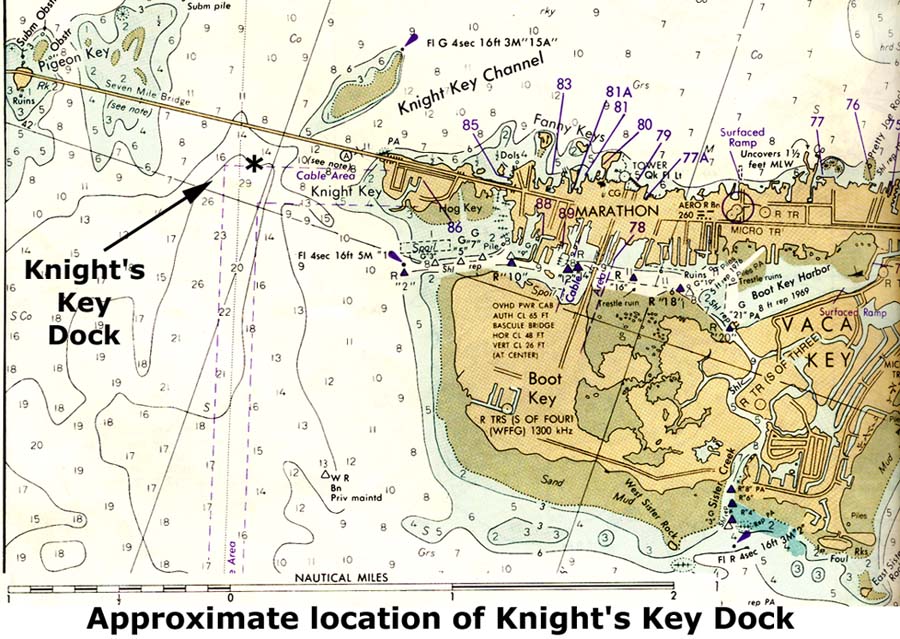 and
about mid-way to Key West was a dead end deep channel in Moser Channel
just south of Knight's Key. Click on the map to enlarge the portion of
a color 1978 navigation map to ascertain water depths (Large file - slow
to download). and
about mid-way to Key West was a dead end deep channel in Moser Channel
just south of Knight's Key. Click on the map to enlarge the portion of
a color 1978 navigation map to ascertain water depths (Large file - slow
to download).
-
The two photos below could be anywhere;
however, the caption on the backs written by Wm. Krome "Dumping Rock on
Lighter, Knight's Key Dock, May 27, 1906" provide a clue. There is no physical
dock in view and the large sailing schooner is using its own clamshell
apparatus. The third photo below depicts such an operation and judging
from the quantity of pilings the ship could have been moored from piles
at Knight's Key Dock. Unloadings such as this was frequently done while
at anchor.
-
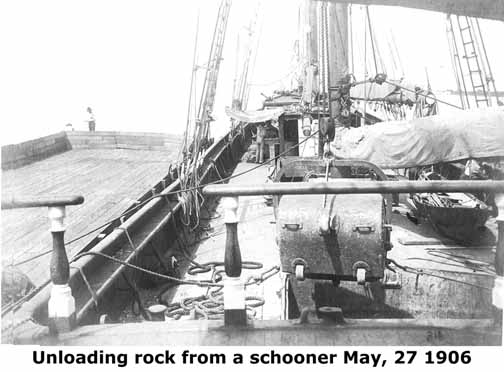 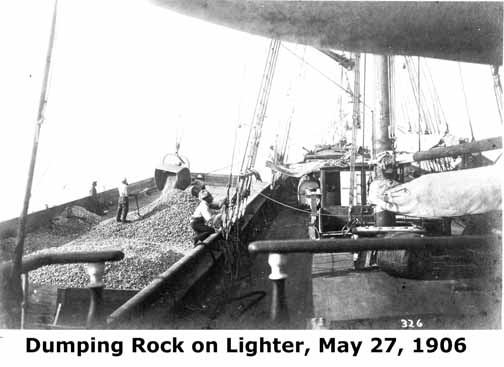
-
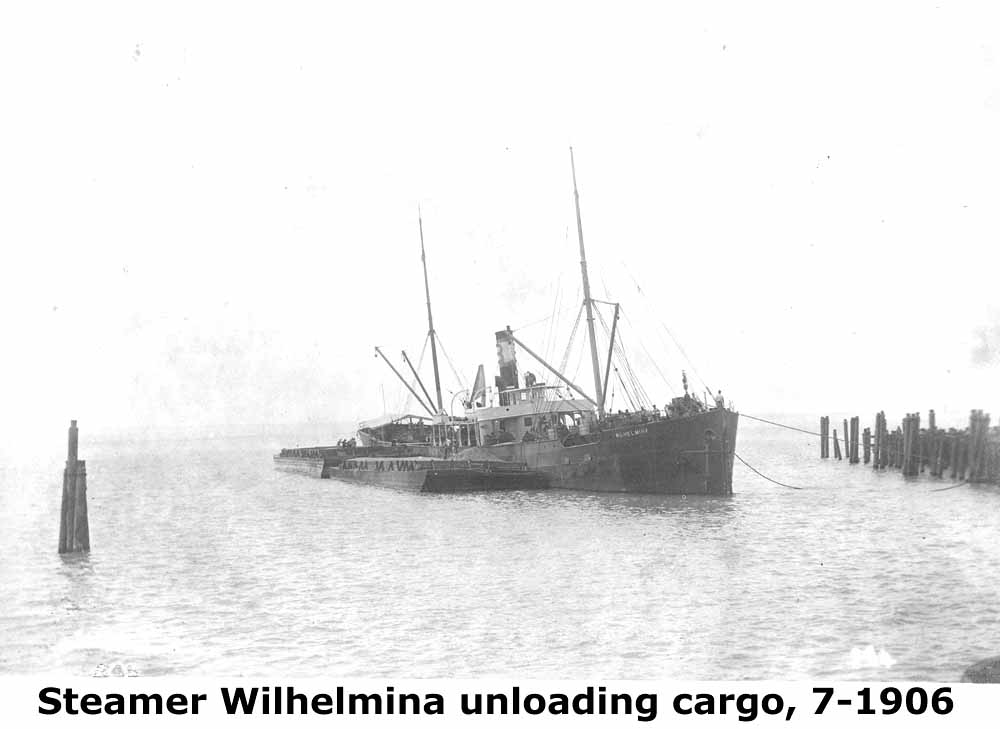 A dated but unidentified newspaper clipping provides a clue, "April 28,
1906 - A large number of workmen are now at work at Knights Key. They will
build warehouses and docks there with the intention of making that Key
a supply station. A large cistern and two big buildings are already on
the Key and lumber and material for the other work is being hauled there
in large quantities. The docks will be built on the west side and extend
out to the 25 foot channel for the accommodation of deep draught vessels."
A dated but unidentified newspaper clipping provides a clue, "April 28,
1906 - A large number of workmen are now at work at Knights Key. They will
build warehouses and docks there with the intention of making that Key
a supply station. A large cistern and two big buildings are already on
the Key and lumber and material for the other work is being hauled there
in large quantities. The docks will be built on the west side and extend
out to the 25 foot channel for the accommodation of deep draught vessels."
-
For the moment we will put aside
the overall big picture concept of Knight's Key Dock and the eventual Seven
 Mile
Bridge, but look at the completed project in reference to the aforementioned
news article. Viewing the photo at the right, the two warehouses are the
ones at the center-left. The track passes in front and forms a "question
mark" shaped curve out to docks in 25 feet of water. Today this would be
about one mile south of the south end of Knight's Key. The docks are in
the distance just to the right of the warehouses. The smoke of a steamship
at the docks can be seen. The two docks actually formed an island mini-city
at the end of a 25-foot finger-like dead end channel from Hawk Channel.
More later, but now back May 1906. Mile
Bridge, but look at the completed project in reference to the aforementioned
news article. Viewing the photo at the right, the two warehouses are the
ones at the center-left. The track passes in front and forms a "question
mark" shaped curve out to docks in 25 feet of water. Today this would be
about one mile south of the south end of Knight's Key. The docks are in
the distance just to the right of the warehouses. The smoke of a steamship
at the docks can be seen. The two docks actually formed an island mini-city
at the end of a 25-foot finger-like dead end channel from Hawk Channel.
More later, but now back May 1906.
-
This introduces a construction
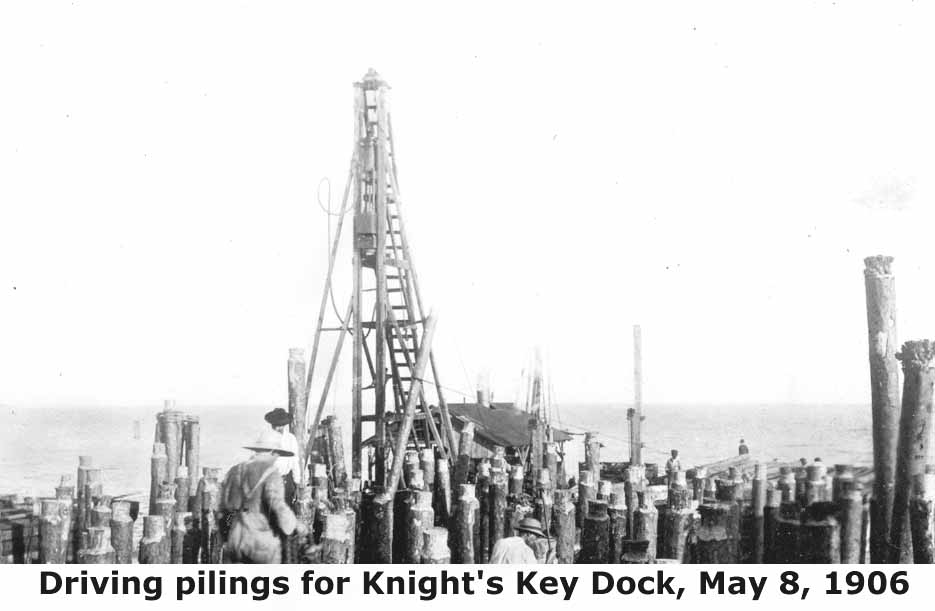 photo from the William J. Krome collection dated May 8, 1906. Obviously,
there had been considerable work done before the April newspaper article
as many piles had been already been put in place. From the width of the
piles this must not be for the track leading out, but be in the future
dock area. The dock area will be large enough to have long warehouse/office/depot
building in the center with a set of tracks on each side in order to accommodate
two trains and two ships at one time.
photo from the William J. Krome collection dated May 8, 1906. Obviously,
there had been considerable work done before the April newspaper article
as many piles had been already been put in place. From the width of the
piles this must not be for the track leading out, but be in the future
dock area. The dock area will be large enough to have long warehouse/office/depot
building in the center with a set of tracks on each side in order to accommodate
two trains and two ships at one time.
-
-
-
The next photo shows support
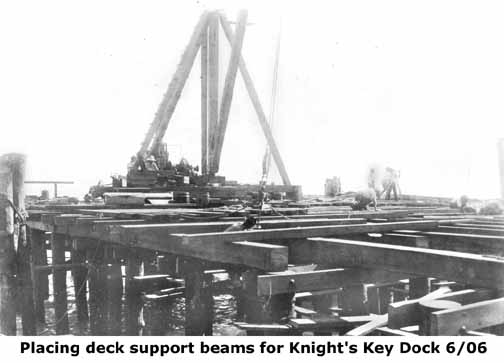 beams for the future dock planks to be laid. From these images a conclusion
can be drawn, possibly incorrect, that the dock area was built first and
then the track trestle between the island of Knight's Key and Knight's
Key Dock. The wooden trestle was about 4,000 feet long. The reader should
not confuse Knight's Key Dock with the actual island of Knight's Key. Writers
often confuse the two.
beams for the future dock planks to be laid. From these images a conclusion
can be drawn, possibly incorrect, that the dock area was built first and
then the track trestle between the island of Knight's Key and Knight's
Key Dock. The wooden trestle was about 4,000 feet long. The reader should
not confuse Knight's Key Dock with the actual island of Knight's Key. Writers
often confuse the two.
-
-
-
The next natural step was to place blanks
or decking onto the support beams. Using the size of the workmen as relative
indicator, these planks are quite thick as they must be the support for
a huge building, two sets of
-
 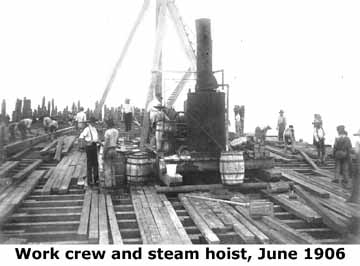
-
railroad tracks and two fully loaded trains. From the dates on the photos
it can be seen that work is proceeding very fast considering that everything
must be brought in. The author assumes that the workforce was quartered
in a quarterboat nearby, but could have been transported from the Boot
Key facility.
-
Now there is a few months' gap
in the author's documented history. The next photo has the date October
3, 1906; however, this was the date of the 1906 Hurricane. This is the
one event that no writings mention until it happened. How much of the structure
was completed must be implied from other documentation.
-
First from a Krome photo. It seen
 that what ever part of the dock it was taken has considerable damage. Much
of the attention of this hurricane was given to the loss of Quarterboat
number 4 which broke loose from its mooring at Long Key and was fully loaded
with workmen. Division engineer Mayo Venable does say in his report that
"One lightre of stone from Knights Key, ashore on the same coast" implying
that the docks were complete enough to unload stone from the huge transport
ships to the barges. Krome, who was in Key West at the time, in a letter
to his father says nothing about the damage at Knight's Key only, "At Knight's
Key I learned the appalling fact that one of the big quarterboats at Long
Key had been swept away . . . . "
that what ever part of the dock it was taken has considerable damage. Much
of the attention of this hurricane was given to the loss of Quarterboat
number 4 which broke loose from its mooring at Long Key and was fully loaded
with workmen. Division engineer Mayo Venable does say in his report that
"One lightre of stone from Knights Key, ashore on the same coast" implying
that the docks were complete enough to unload stone from the huge transport
ships to the barges. Krome, who was in Key West at the time, in a letter
to his father says nothing about the damage at Knight's Key only, "At Knight's
Key I learned the appalling fact that one of the big quarterboats at Long
Key had been swept away . . . . "
-
The clipping file next article
is a Florida Times-Union, December 18, 1906 article, "Because of
the large number of vessels visiting Knight's Key with material for the
railroad extension work, the Key has recently been made a port of entry
with Dr. Cotton as deputy inspector." Therefore, there must not have been
much damage to any permanent structures probably because there were none
at the time.
-
 
-
Although destined to be for passenger
and freight service, there is reason to believe that Knight's Key dock
remained a simple working dock or platform until passenger service could
begin. There would be no reason to have regular passenger and freight buildings
while unloading bulk construction material. Channels 2 and 5 bridges
were first constructed as wooden trestles and later converted to concrete
arch bridges. The Long Key Bridge, nearly two miles long, was the first
major concrete project for the Flagler group, hence the views of so much
gravel.
-
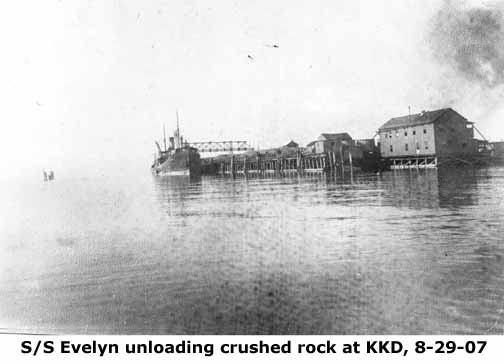 Another photo almost a year later indicates the dock itself is a simple
heavy duty working area. It also shows several buildings no doubt used
partly for living quarters, storage and office space. A U. S. Customs office
was located somewhere on the dock. These buildings could have been there
for some time and just not in view of the cameras. Also, the experience
of the 1906 Hurricane taught them to minimize the use of quarterboats and
build crew quarters where possible.
Another photo almost a year later indicates the dock itself is a simple
heavy duty working area. It also shows several buildings no doubt used
partly for living quarters, storage and office space. A U. S. Customs office
was located somewhere on the dock. These buildings could have been there
for some time and just not in view of the cameras. Also, the experience
of the 1906 Hurricane taught them to minimize the use of quarterboats and
build crew quarters where possible.
-
 Newspapers on February 4, 1908 announced ". . . two trains daily each way
both leaving in the morning." The departure times at Miami were 6:30 a.m.
and 11:00 a.m., and from Knight's Key Dock were 5:40 a.m. and 10:00 a.m.
The 11:00 a.m. from Miami made connections with the steamer Montauk
for Key West and Havana. On May 27, 1908 a post office and telegraph office
were opened. Therefore, the Upper Keys had scheduled train service in 1908.
Round trip excursions from Miami were offered for a day visit. A little
less than four years later, train service will begin to and from Key West
and there will be no access or use for Knight's Key Dock.
Newspapers on February 4, 1908 announced ". . . two trains daily each way
both leaving in the morning." The departure times at Miami were 6:30 a.m.
and 11:00 a.m., and from Knight's Key Dock were 5:40 a.m. and 10:00 a.m.
The 11:00 a.m. from Miami made connections with the steamer Montauk
for Key West and Havana. On May 27, 1908 a post office and telegraph office
were opened. Therefore, the Upper Keys had scheduled train service in 1908.
Round trip excursions from Miami were offered for a day visit. A little
less than four years later, train service will begin to and from Key West
and there will be no access or use for Knight's Key Dock.
-
To continue the history of Knight's
Key Dock on page 2, please Click HERE.
Use Back Arrow to return to reading previous page or:
To return to the Specific Locations and Keys homepage, Click
HERE.
|
History of Knight's Key Dock
The details of how it originated are not clear. Other than photos, there is only underwater evidence in murky waters and swift currents that it existed and its purpose is difficult to perceive. To the right are artifacts retrieved by the late Richard MacAllaster.
and about mid-way to Key West was a dead end deep channel in Moser Channel just south of Knight's Key. Click on the map to enlarge the portion of a color 1978 navigation map to ascertain water depths (Large file - slow to download).
A dated but unidentified newspaper clipping provides a clue, "April 28, 1906 - A large number of workmen are now at work at Knights Key. They will build warehouses and docks there with the intention of making that Key a supply station. A large cistern and two big buildings are already on the Key and lumber and material for the other work is being hauled there in large quantities. The docks will be built on the west side and extend out to the 25 foot channel for the accommodation of deep draught vessels."
Mile Bridge, but look at the completed project in reference to the aforementioned news article. Viewing the photo at the right, the two warehouses are the ones at the center-left. The track passes in front and forms a "question mark" shaped curve out to docks in 25 feet of water. Today this would be about one mile south of the south end of Knight's Key. The docks are in the distance just to the right of the warehouses. The smoke of a steamship at the docks can be seen. The two docks actually formed an island mini-city at the end of a 25-foot finger-like dead end channel from Hawk Channel. More later, but now back May 1906.
photo from the William J. Krome collection dated May 8, 1906. Obviously, there had been considerable work done before the April newspaper article as many piles had been already been put in place. From the width of the piles this must not be for the track leading out, but be in the future dock area. The dock area will be large enough to have long warehouse/office/depot building in the center with a set of tracks on each side in order to accommodate two trains and two ships at one time.
beams for the future dock planks to be laid. From these images a conclusion can be drawn, possibly incorrect, that the dock area was built first and then the track trestle between the island of Knight's Key and Knight's Key Dock. The wooden trestle was about 4,000 feet long. The reader should not confuse Knight's Key Dock with the actual island of Knight's Key. Writers often confuse the two.
that what ever part of the dock it was taken has considerable damage. Much of the attention of this hurricane was given to the loss of Quarterboat number 4 which broke loose from its mooring at Long Key and was fully loaded with workmen. Division engineer Mayo Venable does say in his report that "One lightre of stone from Knights Key, ashore on the same coast" implying that the docks were complete enough to unload stone from the huge transport ships to the barges. Krome, who was in Key West at the time, in a letter to his father says nothing about the damage at Knight's Key only, "At Knight's Key I learned the appalling fact that one of the big quarterboats at Long Key had been swept away . . . . "

Another photo almost a year later indicates the dock itself is a simple heavy duty working area. It also shows several buildings no doubt used partly for living quarters, storage and office space. A U. S. Customs office was located somewhere on the dock. These buildings could have been there for some time and just not in view of the cameras. Also, the experience of the 1906 Hurricane taught them to minimize the use of quarterboats and build crew quarters where possible.
Newspapers on February 4, 1908 announced ". . . two trains daily each way both leaving in the morning." The departure times at Miami were 6:30 a.m. and 11:00 a.m., and from Knight's Key Dock were 5:40 a.m. and 10:00 a.m. The 11:00 a.m. from Miami made connections with the steamer Montauk for Key West and Havana. On May 27, 1908 a post office and telegraph office were opened. Therefore, the Upper Keys had scheduled train service in 1908. Round trip excursions from Miami were offered for a day visit. A little less than four years later, train service will begin to and from Key West and there will be no access or use for Knight's Key Dock.







